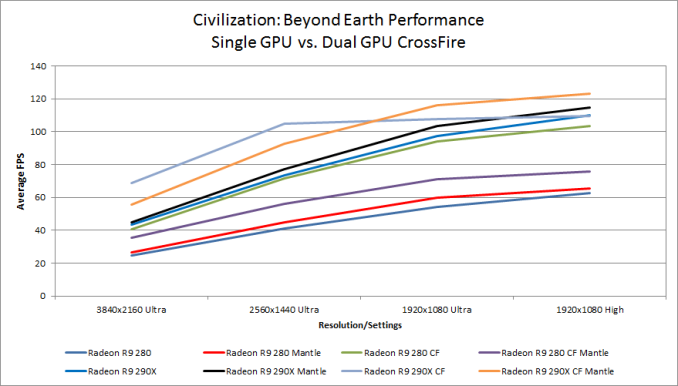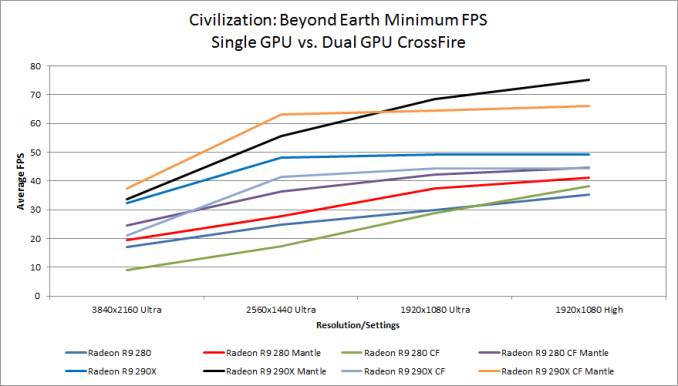Benchmarked - Civilization: Beyond Earth
by Jarred Walton on October 23, 2014 8:00 AM ESTAMD CrossFire Performance
Update, 10/24: Turns out there's a "hidden" setting in the configuration file that needs to be manually enabled for Mantle SFR rendering on CrossFire setups to work. Go to your configuration file (%homepath%\Documents\my games\Sid Meier's Civilization Beyond Earth\GraphicsSettings.ini) and change the one line to say "Enable MGPU=1". This will allow Mantle SFR to work properly. I had to retest CrossFire performance, and the updated results are below, with a more detailed explanation posted in a separate article.
Last but not least we have some early results for CrossFire performance. With the appropriate tweak to the configuration file, Mantle CrossFire support adds an interesting wrinkle to the mix. Regular CrossFire still works as usual, but minimum frame rates take a hit relative to single GPUs even while average framerates improve. Here are a couple graphs showing scaling of performance as we move through the various settings. I've included both single GPU and CrossFire results for the R9 280 and R9 290X, both with and without Mantle:
CrossFire 290X ends up pushing past the 60FPS barrier, even at 4K with 4xMSAA, so that's quite a feat. Except, minimum frame rates take a hit and go from 32FPS with a single 290X to 20FPS with CrossFire 290X. Enabling Mantle changes the story quite a bit; the CrossFire Mantle configuration can't quite push past 60FPS, but at 56FPS it's at least close and the minimum frame rate of 37FPS is better than both the single GPU and single GPU with Mantle figures.
We can also see quite nicely in this graph that the CPU bottleneck at High and Ultra settings is around 110-120FPS, even with a 4.1GHz Core i7-4770K, while our minimum FPS bottleneck is even lower: 65FPS for CrossFire Mantle and 49FPS with a single 290X (without Mantle).
As for the R9 280 CF configuration, the two Tahiti GPUs (without Mantle) come just short of matching the performance of a single R9 290X Hawaii card. Mantle again improves minimum frame rates, but the gap between R9 290X Mantle and R9 280 CF Mantle grows. This is one more reason why we generally prefer single GPU configurations, at least up to the point where you have the fastest GPU you can buy.












72 Comments
View All Comments
Parrdacc - Thursday, October 23, 2014 - link
Well, have a Happy Birthday!!przemo_li - Thursday, October 23, 2014 - link
I think that You make good point about $$ on CPU vs $$ on GPU... for now.Cause if Mantle can let us spent $$$ less on CPU then, why not?
(That ofc. would require more widespread support in games.... Or DX12 Or OpenGL AZDO)
nevertell - Thursday, October 23, 2014 - link
Not necessarily. Civilization V was a cpu limited game for the most part.LemmingOverlord - Friday, October 24, 2014 - link
indeed, Civ V was a great CPU benchmark (akin to Supreme Commander), and the performance scaled quite well with added cores...SuperVeloce - Friday, October 24, 2014 - link
Civ V scaled well with up to 4 cores if my memory serves me right. Not much more with 6+ cores.just4U - Friday, October 24, 2014 - link
I was playing civ5 this past week while waiting for the new game... and you know... even on my 4790K it bogs down on big maps.jaredjeya - Friday, October 24, 2014 - link
Especially as turn time and not FPS becomes the limiting factor late into the game. Anything above 20fps is decent, but if turns take a minute then it's intolerable.doronnac - Thursday, October 23, 2014 - link
Min. FPS should be tested as it's more important than average when almost all cards demonstrate more than playable performance even at 4K.Mikemk - Thursday, October 23, 2014 - link
"the built-in benchmark basically represents something of a worst-case scenario for performance"Page 1
JarredWalton - Thursday, October 23, 2014 - link
I have logs including minimum FPS, but time constraints kept me from spending too much effort analyzing them. What I can say is that when the game zooms all the way out during the benchmark sequence, that's when the minimum occurs and it's usually around 2/3 of the average FPS. GPUs with less VRAM may also be hit harder though. Let me see if I can add some charts for minimums, now that I've managed to get some sleep. :-)